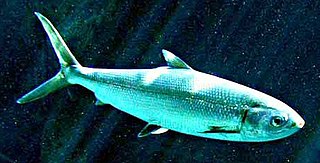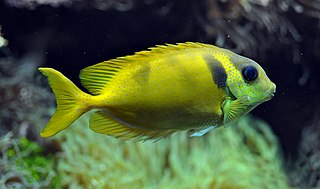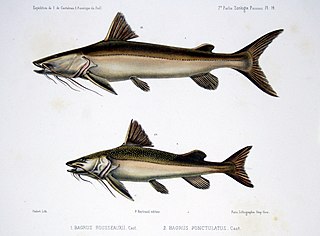
Cyprinidae is a family of freshwater fish commonly called the carp or minnow family, including the carps, the true minnows, and their relatives the barbs and barbels, among others. Cyprinidae is the largest and most diverse fish family, and the largest vertebrate animal family overall, with about 3,000 species; only 1,270 of these remain extant, divided into about 200 valid genera. Cyprinids range from about 12 mm (0.5 in) in size to the 3 m (9.8 ft) giant barb. By genus and species count, the family makes up more than two-thirds of the ostariophysian order Cypriniformes. The family name is derived from the Greek word kyprînos.

Catfish are a diverse group of ray-finned fish. Named for their prominent barbels, which resemble a cat's whiskers, catfish range in size and behavior from the three largest species alive, the Mekong giant catfish from Southeast Asia, the wels catfish of Eurasia, and the piraíba of South America, to detritivores, and even to a tiny parasitic species commonly called the candiru, Vandellia cirrhosa. Neither the armour-plated types nor the naked types have scales. Despite their name, not all catfish have prominent barbels or "whiskers". Members of the Siluriformes order are defined by features of the skull and swimbladder. Catfish are of considerable commercial importance; many of the larger species are farmed or fished for food. Many of the smaller species, particularly the genus Corydoras, are important in the aquarium hobby. Many catfish are nocturnal, but others are crepuscular or diurnal.

Characiformes is an order of ray-finned fish, comprising the characins and their allies. Grouped in 18 recognized families, more than 2000 different species are described, including the well-known piranha and tetras.

Characidae, the characids or characins, is a family of freshwater subtropical and tropical fish belonging to the order Characiformes. The name "characins" is an historical one, but scientists today tend to prefer "characids" to reflect their status as a, by and large, monophyletic group. To arrive there, this family has undergone much systematic and taxonomic change. Among those fishes remaining in the Characidae currently are the tetras, comprising the very similar genera Hemigrammus and Hyphessobrycon, as well as a few related forms, such as the cave and neon tetras. Fish of this family are important as food in several regions, and also constitute a large percentage of captive freshwater aquarium fish species.

The term carp is a generic common name for numerous species of freshwater fish from the family Cyprinidae, a very large clade of ray-finned fish mostly native to Eurasia. While carp are prized quarries and are valued as both food and ornamental fish in many parts of the Old World, they are considered trash fish and invasive pests in many parts of Africa, Australia and most of the United States.

Cypriniformes is an order of ray-finned fish, which includes many families and genera of cyprinid fish, such as barbs, gobies, loaches, botias, and minnows. Cypriniformes is an “order-within-an-order”, placed under the superorder Ostariophysi—which is also made up of cyprinid, ostariophysin fishes. The order contains 11-12 families, over 400 genera, and more than 4,250 named species; new species are regularly described, and new genera are recognized frequently. Cyprinids are most diverse in South and Southeast Asia, but are entirely absent from Australia and South America. At 112 years old, the longest-lived cypriniform fish documented is the bigmouth buffalo.

The Gonorynchiformes are an order of ray-finned fish that includes the important food source, the milkfish, and a number of lesser-known types, both marine and freshwater.

Callichthyidae is a family of catfishes, called armored catfishes due to the two rows of bony plates along the lengths of their bodies. It contains some of the most popular freshwater aquarium fish, such as many species in the genus Corydoras.

Neopterygii is a subclass of ray-finned fish (Actinopterygii). Neopterygii includes the Holostei and the Teleostei, of which the latter comprise the vast majority of extant fishes, and over half of all living vertebrate species. While living holosteans include only freshwater taxa, teleosts are diverse in both freshwater and marine environments. Many new species of teleosts are scientifically described each year.

The Amazon basin is the part of South America drained by the Amazon River and its tributaries. The Amazon drainage basin covers an area of about 7,000,000 km2 (2,700,000 sq mi), or about 35.5 percent of the South American continent. It is located in the countries of Bolivia, Brazil, Colombia, Ecuador, Guyana, Peru, Suriname, and Venezuela, as well as the territory of French Guiana.

The channel catfish is North America's most numerous catfish species. It is the official fish of Kansas, Missouri, Nebraska, and Tennessee, and is informally referred to as a "channel cat". In the United States, they are the most fished catfish species with around 8 million anglers targeting them per year. They also have very few teeth and swallow food whole. The popularity of channel catfish for food has contributed to the rapid expansion of aquaculture of this species in the United States. It has also been widely introduced in Europe, Asia and South America, and it is legally considered an invasive species in many countries.

The Weberian apparatus is an anatomical structure that connects the swim bladder to the auditory system in fishes belonging to the superorder Ostariophysi. When it is fully developed in adult fish, the elements of the apparatus are sometimes collectively referred to as the Weberian ossicles or Weber's ossicles. The presence of the structure is one of the most important and phylogenetically significant distinguishing characteristics of the Ostariophysi. The structure itself consists of a set of minute bones that originate from the first few vertebrae to develop in an embryonic ostariophysan. These bones grow to physically connect the auditory system, specifically the inner ear, to the swim bladder. The structure acts as an amplifier of sound waves that would otherwise be only slightly perceivable by the inner ear structure alone.

The Aspredinidae are a small South American family of catfishes also known as the banjo catfishes, with about 43 species.

Erethistidae are a family of catfishes that originate from southern Asia. It includes about 45 species.

Brachyplatystoma is a genus of catfish from the family Pimelodidae. As the occasionally used common name goliath catfishes indicates, this genus includes some of the largest species of catfish, including the piraíba, B. filamentosum, which reaches up to the region of 3.6 metres (12 ft) in length. Brachyplatystoma are found in the Amazon and Orinoco basins, and other tropical freshwater and brackish habitats in South America. Some species are migratory. These fish are important as food fish and, to some extent, aquarium fish.

Cavefish or cave fish is a generic term for fresh and brackish water fish adapted to life in caves and other underground habitats. Related terms are subterranean fish, troglomorphic fish, troglobitic fish, stygobitic fish, phreatic fish, and hypogean fish.
Santanichthys diasii is a species of extinct fish that existed around 115 million years ago during the Albian age. S. diasii is regarded as the basal-most characiform, and is the earliest known member of Otophysi. It appears as a small fish, similar in appearance to a modern-day herring little more than 30 millimeters in length. Its most striking characteristic is the presence of a Weberian apparatus, which makes it the most primitive known member of the order Characiformes, the order in which modern-day tetras are classified. Santanichthys has been unearthed from numerous locations throughout Brazil, in rocks dating to the Cretaceous Period. Its presence in these strata is seen as an indicator for the biogeography and evolution of its order.

Otocephala is a clade of ray-finned fishes within the infraclass Teleostei that evolved some 230 million years ago. It is named for the presence of a hearing (otophysic) link from the swimbladder to the inner ear. Other names proposed for the group include Ostarioclupeomorpha and Otomorpha.

Teleosteomorpha is a clade of ray-finned fishes containing all teleost fish and their closest extinct relatives. Also in this group are two diverse Mesozoic fish orders, the Aspidorhynchiformes and the Pachycormiformes. Several other non-teleostomorph teleosteans existed throughout the Mesozoic, although not as dominant as the two main clades in the group.


















